

Do We Look Fat in These Suburbs? People in dense cities are thinner and have healthier hearts than people in sprawling subdivisions.
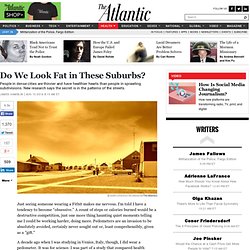
New research says the secret is in the patterns of the streets. Just seeing someone wearing a Fitbit makes me nervous. I'm told I have a tendency to become “obsessive.” A count of steps or calories burned would be a destructive competition, just one more thing haunting quiet moments telling me I could be working harder, doing more. Pedometers are an invasion to be absolutely avoided, certainly never sought out or, least comprehensibly, given as a "gift. " A decade ago when I was studying in Venice, Italy, though, I did wear a pedometer. Is that all it takes to make a healthy city? In places where there are streets, the particular effects of their layout on health are less known. Social isolation a critical issue facing our elderly. Tuesday, 21 June 2011 The University of Adelaide will lead an Australian-first study to reduce social isolation among older people, identified as one of the most serious mental and physical health risks facing the nation.
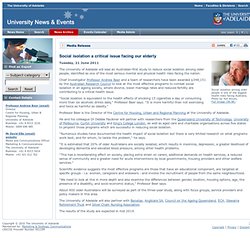
Chief Investigator Professor Andrew Beer and a team of researchers have been awarded $348,151 by the Australian Research Council to look at the most effective programs to combat social isolation in an ageing society, where divorce, lower marriage rates and reduced fertility are contributing to a critical health issue. "Social isolation is equivalent to the health effects of smoking 15 cigarettes a day or consuming more than six alcoholic drinks daily," Professor Beer says.
"It is more harmful than not exercising and twice as harmful as obesity. " Professor Beer is the Director of the Centre for Housing, Urban and Regional Planning at the University of Adelaide. The results of the study are expected in mid 2014. Switchboard, from NRDC. Google's New Moonshot Project: the Human Body. Livable Communities - AARP Public Policy Institute.
Livability Resources - Housing, Transportation, Age-Friendly Communities. Toolkit-older-adults. 21 Features of the Sustainable City. We already have many of the ideas and inventions that are needed to make cities truly sustainable, but there is a considerable delay in implementation caused by entrenched thinking and lack of training amongst those in administrative positions.

Other ingredients that will arrive from left field are presently in development but will need to be brought into the mix. In this article I make an attempt to summarise many of the key elements. In the comments section you are welcome to suggest more. Finance and auditing Joined-up action. Transport. Christoph Gielen’s Aerial Photographs Document the Failures of Sprawl. 07/14/2014 by Jared Green All photographs from the book Ciphers, cropped / Copyright Christoph Gielen.
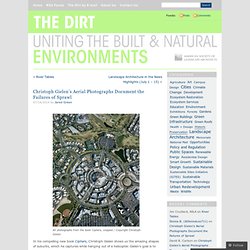
Architect This City. We believe that a nation full of healthy, thriving communities is closer than you think—and to get there, we’ll need to work and learn together. Volume 1 — Understanding the Market — Webinar. Housing for Older Canadians: The Definitive Guide to the Over-55 Market Volume 1 — Understanding the Market [Slide 2] Housing for Older Canadians — The Definitive Guide to the Over-55 Market is an on-line series of five volumes for builders, developers and non-profit or community groups who want to sponsor housing projects for older Canadians.
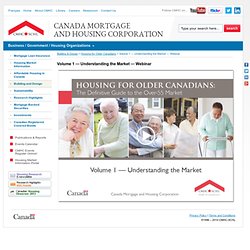
It offers detailed information on planning, developing and designing a successful housing project targeted to older Canadians, as well as on the range of options for partnering with public or private sector providers that specialize in the management and/or delivery of services to them. For further information, download the 5-volume series from www.cmhc.ca. [Slide 3] This Webinar provides an overview of Volume 1 — Understanding the Market. This Exercise App Tracks Trends on How We Move In Different Cities. The developers of Human have complied user data into stunning visualizations that show how and where we get around.
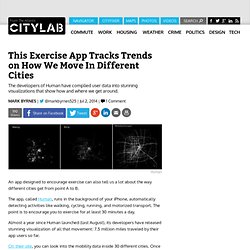
An app designed to encourage exercise can also tell us a lot about the way different cities get from point A to B. The app, called Human, runs in the background of your iPhone, automatically detecting activities like walking, cycling, running, and motorized transport. The point is to encourage you to exercise for at least 30 minutes a day. Almost a year since Human launched (last August), its developers have released stunning visualization of all that movement: 7.5 million miles traveled by their app users so far. Transforming Communities to Reduce Stress and Improve Health. But we don’t have to live like this.
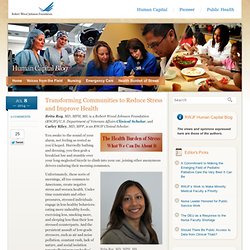
We can strategically shape our neighborhoods and our work environments to lower stress, build resilience, and promote health. Seem like a pipe dream? Well, while this may, at first blush, seem like a description of an unrealistic utopia as fantastic as The Truman Show, it is actually within reach. Communities can take action and change their environments to reduce chronic stress and promote health. As an example, back in the 1970s, the residents of San Luis Obispo, Calif., started making changes to their city to promote well-being instead of commercialism.
Transforming Communities to Reduce Stress and Improve Health. Planning & Design Centre. Neighbourhoods. Planning & Design Centre. Mid-Michigan Health Impact Assessment Toolkit - Home. Clasp_2012. Sustainable Prosperity.